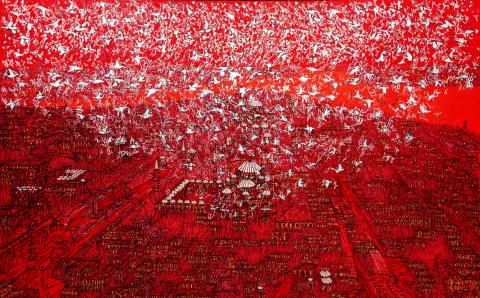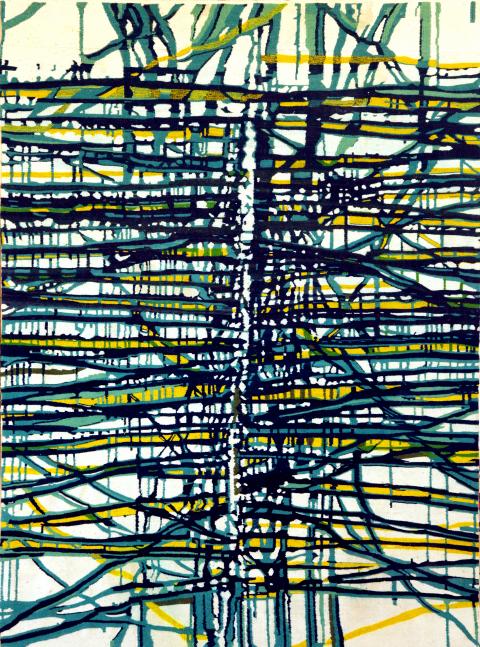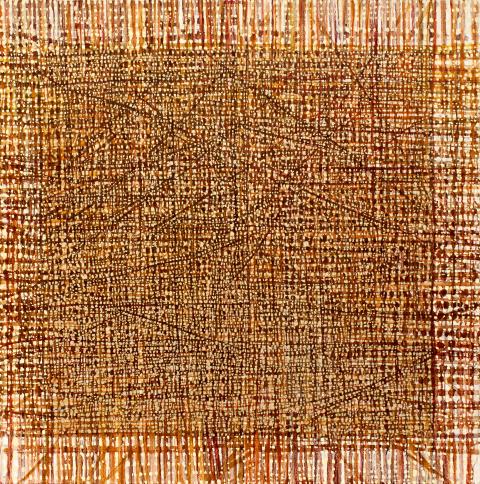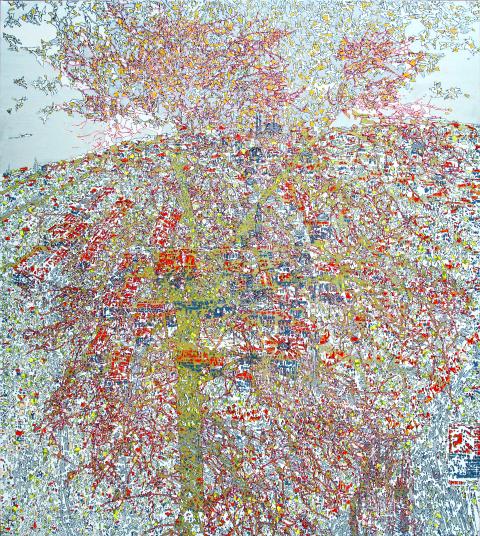Rhythm, lines and Turkish tradition are among the words used to describe the art of Devrim Erbil, a key figure in the development of modern Turkish painting whose artistic career has spanned more than half a century. The National Museum of History (國立歷史博物館) is currently holding an exhibition, Poetical Abstraction From Istanbul (詩意的抽象—來自伊斯坦堡), of work by the internationally-renowned artist, including recent abstract paintings and textile-art, that eloquently illustrate his preoccupations with motifs such as birds, trees, rhythmic composition and the cityscapes of Istanbul.
Born in 1937 in the carpet-weaving province of Usak, Central Anatolia, Erbil studied painting at the respected State Academy of Fine Arts in Istanbul during the 1950s, and soon garnered recognition as an abstract painter at home and abroad. A prolific artist who, at the age of 76, still reportedly works seven to 12 hours a day, Erbil has also served as an academic at several art institutions in Turkey and helped to influence a younger generation of Turkish artists.
Although trained in the abstract tradition of European masters such as Paul Klee and Piet Mondrian, Erbil nevertheless seeks inspiration in the culture, tradition and landscapes of Turkey, particularly Anatolia, the Asian part of the nation. He renders Istanbul in intricate lines and shapes and always from an aerial perspective. From a distance, the city’s maze of streets, mosques and the Bosphorus, a strait that is part of the border separating Europe and Asia, appear sketched or engraved on the canvas and often painted in vibrant colors of red, green and Turkish blue. A closer look, however, reveals an immense complexity composed of straight and broken lines, curves and their variations in various hues.

Photo courtesy of the Turkish Trade Office in Taipei
Erbil’s abstract paintings are also suffused with images of nature. Subjects like the flapping of a bird’s wings or the branches and leaves of a tree, which seem to expand and grow to infinity, are often unrecognizable, while a sense of rhythmic motion and dynamism is deeply felt in the artist’s intricately detailed rendering.
Believing that art is made for sharing, Erbil has worked with a variety of media that ranges from mosaics, ceramics and stained glass to tapestry. Among them, Anatolian carpet occupies a special position in the creative world of Erbil, who once said that carpets are the Turks gift to humanity. Several of Erbil’s textile-art works that adopt ancient weaving techniques are on display at the museum, aiming to change the viewer’s ideas of carpets not only as a piece of decoration on the floor but as an artwork that can be hung on the wall.
■ National Museum of History (國立歷史博物館), 49 Nanhai Rd, Taipei City (台北市南海路49號), tel: (02) 2361-0270. Open Tuesdays to Sundays from 10am to 6pm. General admission: NT$30. On the Net: www.nmh.gov.tw

Photo courtesy of the Turkish Trade Office in Taipei
■ Until Oct. 2

Photo courtesy of the Turkish Trade Office in Taipei

Photo courtesy of the Turkish Trade Office in Taipei

We lay transfixed under our blankets as the silhouettes of manta rays temporarily eclipsed the moon above us, and flickers of shadow at our feet revealed smaller fish darting in and out of the shelter of the sunken ship. Unwilling to close our eyes against this magnificent spectacle, we continued to watch, oohing and aahing, until the darkness and the exhaustion of the day’s events finally caught up with us and we fell into a deep slumber. Falling asleep under 1.5 million gallons of seawater in relative comfort was undoubtedly the highlight of the weekend, but the rest of the tour

Youngdoung Tenzin is living history of modern Tibet. The Chinese government on Dec. 22 last year sanctioned him along with 19 other Canadians who were associated with the Canada Tibet Committee and the Uighur Rights Advocacy Project. A former political chair of the Canadian Tibetan Association of Ontario and community outreach manager for the Canada Tibet Committee, he is now a lecturer and researcher in Environmental Chemistry at the University of Toronto. “I was born into a nomadic Tibetan family in Tibet,” he says. “I came to India in 1999, when I was 11. I even met [His Holiness] the 14th the Dalai

Following the rollercoaster ride of 2025, next year is already shaping up to be dramatic. The ongoing constitutional crises and the nine-in-one local elections are already dominating the landscape. The constitutional crises are the ones to lose sleep over. Though much business is still being conducted, crucial items such as next year’s budget, civil servant pensions and the proposed eight-year NT$1.25 trillion (approx US$40 billion) special defense budget are still being contested. There are, however, two glimmers of hope. One is that the legally contested move by five of the eight grand justices on the Constitutional Court’s ad hoc move

Stepping off the busy through-road at Yongan Market Station, lights flashing, horns honking, I turn down a small side street and into the warm embrace of my favorite hole-in-the-wall gem, the Hoi An Banh Mi shop (越南會安麵包), red flags and yellow lanterns waving outside. “Little sister, we were wondering where you’ve been, we haven’t seen you in ages!” the owners call out with a smile. It’s been seven days. The restaurant is run by Huang Jin-chuan (黃錦泉), who is married to a local, and her little sister Eva, who helps out on weekends, having also moved to New Taipei